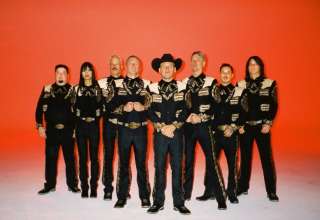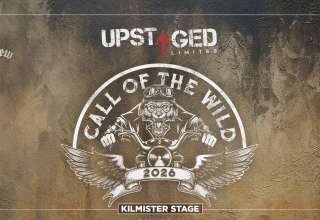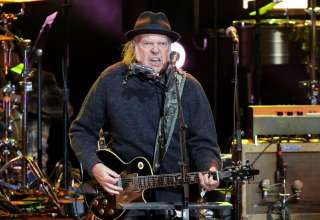Review & Photography by Nathan Vestal for MPM
The Sylvee felt restless long before the doors opened, the kind of low buzz that builds when three different breeds of heavy music collide in one room on a cold Wisconsin night.
Outside, people stamped their feet against the November chill, pulling hoodies tight and trading guesses about setlists while the line grew longer. Madison doesn’t always behave like a metal city, but every so often a tour rolls through that activates something in the local DNA. This one did. Fans showed up early. They came layered, impatient, and ready.
Inside, the humid blast of body heat and the fog of early-evening anticipation made the room feel smaller than usual. People hurried to the barricade. Others headed for the bar. And an even larger group assembled in line once again for merch.
SpiritWorld
SpiritWorld walked onto the stage before most fans were fully settled, but their arrival cut through the chatter like a sudden drop in temperature. There was no intro tape, no buildup – just a swell of thick red light, a slow bloom of smoke, and Stu Folsom stepping forward as if emerging from a graveyard. With dark shades, a clean black appliqued and rhinestone studded suit, he looked not like a performer, but a figure dragged out of some half-remembered frontier myth. A gunslinger, a prophet, a ghost – pick your metaphor, they all fit.

The first riff of “Waiting on the Reaper” hit like a blunt instrument. SpiritWorld’s sound is a collision of metallic hardcore, thrash, and Western-gothic atmosphere, a combination that shouldn’t work as well as it does. Live, the pieces fuse together more clearly than on record. The guitars sounded serrated, each chord sharp enough to draw figurative blood. The drums galloped with the momentum of a horse barreling through dry brush – relentless, dusty, and pounding. There’s a strange ritualistic quality to the way SpiritWorld moves through a set, as if every tempo shift marks the next phase in some violent, sun-scorched narrative.

Folsom didn’t have pace or posture. Instead, he stalked the stage with slow, deliberate steps, shoulders forward, hands occasionally clenched into fists as he bellowed lyrics with a preacher’s conviction and a brawler’s grit. The crowd reacted quickly. During “Moonlit Torture,” the first real pit of the night opened fast and wide, bodies colliding under the stuttering rhythm of the breakdown. The lighting shifted to stark whites and deep shadows, creating a strobe-like illusion of explosions across the stage. People who had clearly never heard the band before were nodding along by instinct. Even the skeptics—arms crossed, beer raised—were tapping their feet by the halfway point.

Folsum took a break to introduce the Las Vegas-based band and shared that it was the band’s first performance in Wisconsin. Guitarist Matt Schrum, originally from Oconomowoc, was proud to have his grandma in attendance, while Folsom joked that while they were slowly converting her to a death metal fan, you’d find her in the pit chanting “Bears still suck!” which incited the Packers fans in the room to cheer harder.

SpiritWorld’s set peaked during “U L C E R,” when a moment of near-silence fell before the band launched into a slow, ominous intro that set the room on edge. The tension broke in a wave of motion as the tempo snapped into high gear, sending the pit into one final frenzy. It was a moment of pure release, earned and explosive. When the last note died out, Folsom stepped back, gave a single sharp nod, and walked offstage without ceremony. No flourish. No grand wave. They arrived like a storm front and left like desert wind—sudden, dry, gone. The crowd was left buzzing, visibly impressed, already shifting expectations upward for the night.
Alien Weaponry
The lights dimmed again, and the stage crew moved with quickness that suggested the room was about to shift in tone. When Alien Weaponry appeared, it did. A darkness fell over the venue—not moody, but anticipatory, like the quiet before a cannon blast. And then it happened: the haka.
If you’ve never seen the de Jong brothers and Tūranga Morgan-Edmonds perform it live, it’s difficult to convey the gravity. The crowd fell silent. Fists tightened. The stomp of feet and rhythmic shouts hit the chest like blunt trauma. It didn’t feel like an intro. It felt like being invited—no, commanded—into a different cultural space. Phones shot up for the first few beats, but many people lowered them again, recognizing that witnessing it mattered more than capturing it.

When the haka snapped into the opening notes of “Rū Ana Te Whenua,” the room erupted. Alien Weaponry play like a band with nothing to prove and everything to protect. Henry de Jong’s drumming is a kind of controlled violence—precision hits, impeccably timed flourishes, and fills that feel like he’s carving the tempo out of stone. Lewis de Jong’s guitar work has become sharper, more textured; he slides between chugging thrash riffs and melodic lines with a confidence that suggests a musician who grew up inside the music rather than learned it. Morgan-Edmonds, always the anchor, slammed heavy bass lines that hit like falling pillars, keeping everything grounded even as the crowd surged.

The chemistry between the three is startlingly tight for such young players. They don’t waste motion. They don’t overplay. Their stage presence has matured into something uniquely their own – not theatrical, not stoic, but rooted, rhythmic, and intensely connected to the stories they carry. When Lewis shouted the first lines of “Te Riri o Tāwhirimātea,” the room leaned forward as though pulled. The Māori lyrics didn’t need translation; the cadence communicated urgency on its own. Every drum hit punctuated the language. Every chord emphasized it. You could feel the weight of history embedded in the sound.

Between songs, the band interacted lightly but warmly. Henry flashed a grateful, almost shy smile as the crowd roared after a particularly blistering sequence. Morgan-Edmonds prowled the edge of the stage, pointing to different corners of the room, coaxing movement with small gestures. In preparation for their performance of “Taniwha” Lewis polled the crowd to gauge for fans of Lamb of God, speaking of the band’s collaboration with Randy Blythe on the track. Lewis, the most animated of the three, showed his appreciation for his musical influence during the performance by whipping his hair in tight arcs while still nailing every riff with frightening accuracy.

The emotional peak came during “Kai Tangata”. The opening groove hit like a war drum, and the crowd immediately detonated. Bodies collided, arms windmilled, and voices rose in uneven but deeply committed shouts of the chorus. It felt less like a song and more like a communal exorcism. The band fed off it. Lewis’s face twisted into a triumphant grin as the entire floor bounced in unison. Henry’s snare cracks became sharper, louder, more urgent. Morgan-Edmonds kept the low end pounding until the floor itself vibrated.

Alien Weaponry didn’t just impress – they overwhelmed. Their set didn’t feel like a performance; it felt like an assertion of identity, culture, and purpose. A statement. A demand to be heard. When they bowed and excited, the applause carried a tone of reverence typically reserved for longtime legends, not a band barely into adulthood.
Avatar
By the time Alien Weaponry’s gear was hauled off and Avatar’s stagehands began unfurling the trappings of a traveling metal carnival, the energy inside The Sylvee had shifted into something sharp and focused. The crowd pressed tight toward the barricade, bodies angled forward like sprinters waiting for a gunshot. Madison isn’t easily intimidated, but the way Avatar manipulates anticipation – how they stretch silence, how they let the darkness sit – felt almost predatory.
Then it happened: total blackout. A long one. The kind that makes a room collectively inhale and hold it.

When the lights rose to a dim glow, all five band members emerged, lit by a lantern held by frontman Johannes Eckerström, cloaked in a black hood, covered from head to toe. The crowd remained mostly motionless during the rather solemn “Captain Goat” melodic shanty opening.
After a quick set and lighting transition, a single spotlight tore through the fog and suddenly the band detonated into “Silence in the Age of Apes”. Everything – lights, sound, bodies – erupted at once. The Sylvee became a pressure chamber. At this point, Eckerström had shed the cloak, revealing his trademark makeup, glint in his eyes, and menacing smile. He carried himself with the regal menace of a circus ringleader whose show always ends with someone bleeding.

Eckerström moved with alarming precision: stiff-backed one second, serpentine the next, occasionally breaking into a wild, waltzing spin that felt half celebratory and half threatening. His voice was absurdly controlled, alternating between guttural roars, theatrical croons, and chilling falsetto whispers. He treats his vocal cords like an instrument sharpened on a whetstone.
Behind him, the rest of Avatar operated like a well-oiled war machine. Jonas “Kungen” Jarlsby, with his signature golden guitar and imposing Viking-like stoicism, looked as though he were carved from granite and powered by electricity. Tim Öhrström, the more animated counterpart, darted between lead and rhythm parts while trading mischievous looks with the front rows. Their harmonized leads had bites – melodic enough to elevate the songs, vicious enough to avoid sentimentality.

The rhythm section, John Alfredsson on drums and Henrik Sandelin on bass, held everything together with militaristic tightness. Alfredsson’s drumming was a masterclass in force without chaos. His kick patterns landed like heavy machinery pounding through concrete. Sandelin’s basslines rumbled with a snarling clarity that gave the entire performance a physical weight you could feel in your sternum.
Eckerström interacted with the audience more than most frontmen. At this point, I was already torn between watching the onstage explosion of hair and leather when each band member headbanged in unison and doing it myself. Then Eckerström insisted that the band play faster and harder, and challenged the crowd to keep up, shrieking that Avatar is “In the Airwaves”, next playing the namesake song for the tour and single from the2025 album Don’t Go In The Forest.

The band’s showmanship was more than props and makeup; it was infrastructure. Every lighting cue, every fog burst, every rhythmic pause had a purpose. During “The Eagle Has Landed,” Eckerström prowled the stage like he was measuring it for conquest. He’d lean into the crowd, so close to the front row could see the cracks in his greasepaint, then snap back into formation with the rest of the band like a puppet whose strings had been yanked.
Eckerström delivered “Death and Glitz,” with a feral grin and a level of enthusiasm typically only seen in Saturday night festival headliners – not a Tuesday in Wisconsin. The riffs hit like spiked carnival mallets. The crowd responded accordingly, the pit erupting again in a celebratory frenzy. Eckerström strutted across the stage like a painted tyrant enjoying the spectacle of his kingdom tearing itself apart.

“Colossus” shifted the mood entirely. The lighting dimmed to a chilly blue-gray, and the fog thickened until the band looked like silhouettes in a dream. Eckerström’s voice softened into something eerie and haunting, the guitar lines stretching with mournful elegance. The crowd, exhausted from movement, fell into a mesmerized stillness. Even the pit stilled to a gentle sway, as if the song had pressed a finger to everyone’s lips and whispered, shhh.
Then came the opposite: Eckerström serenaded the crowd while playing the piano and addressed the room with a kind of grandiose sincerity that borders on unsettling. He thanked the crowd not with the typical metal-band bravado but with the gravitas of a ringmaster grateful his audience survived the show. He assured us that Avatar will return to Madison, the city they hold dear for so many supporters early in the band’s career. His grateful monologue didn’t feel scripted – it felt like a sermon from some alternate, slightly deranged religion.

What stands out most about Avatar live is how much intent they put into pacing. They sculpt tension like theater veterans, guiding the audience through emotional peaks and valleys rather than just stacking songs on top of each other. The quiet moments feel ominous, the fast one’s cathartic. They execute humor with the same skill they apply to menace; Eckerström’s sly, crooked smile before a tempo shift is enough to send the crowd screaming.
When “Hail the Apocalypse” started, it hit like a hammer dropped from orbit. The song’s stomping rhythm pushed the entire room into a near-pandemonium. The chorus slammed out of a thousand throats. The pit went for one last glorious spin, fueled by the adrenaline of a crowd unwilling to let the night end quietly.

And when it did end – lights cut, stage emptied, silence returned – it happened instantly. Avatar disappeared the same way they appeared: completely, as if swallowed by their own theatrics. No lingering notes. No slow fade. Just blackouts, a gasp, and the afterglow of spectacle.
The crowd poured out onto the freezing Madison pavement in a kind of shared daze – sweaty, exhilarated, overwhelmed. People talked about Alien Weaponry with reverence. They buzzed about SpiritWorld’s ferocity. But Avatar? Avatar was what they felt in their muscles.
SpiritWorld stunned them.
Alien Weaponry grounded them.
Avatar rearranged them.
For a midweek show, it was something close to miraculous – a night where heavy music didn’t just entertain but enveloped, transformed, and branded itself into memory.







